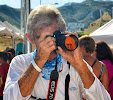
Bubba-Class rooster caught by Josh Dickenson using the ‘ladyfish’ technique
If you spend any time at all on Baja beaches you are going to see some incredibly large shadows cruising along the shoreline in shallow water. It is only when the shadow finds ‘something to eat’ that the shape suddenly materializes into a fish with vivid gunmetal grey stripes and a comb-like dorsal as it appears above the surface of the sparkling Sea of Cortez.
When this happens, you will have just been introduced to some of the largest roosterfish found in Baja. Nicknamed “Bubba” by many, these big shouldered, unusual looking fish with the attitude of a red neck at a Saturday night bar fight are one of the toughest fish to get to bite, let alone catch in Baja.
Years ago, my wife, Yvonne, and I were enjoying a fun morning catching ladyfish from the beach. Ladyfish are a small tarpon like fish that can be anywhere from 12” – 24” inches and are a sucker for small chrome spoons. Their acrobatics as they leap into the air are spectacular. As she was reeling in a ladyfish, “Bubba” came streaking toward her and snatched her fish like a dog grabbing a bone, and headed straight for the deep water. Of course Yvonne never got a hook in the monster, but it was fun to watch, and my brain was spinning with how to put what we had just seen to good use.
Later that year over a cocktail or two, Don Sloan, a fishing buddy and I, hatched this elaborate scheme to catch “Bubba”.
In those days, we fished the East Cape beaches astride ATV’s equipped with rod holders, tackle boxes, etc. For this adventure, we added aerators to our coolers to make live bait tanks and wore headsets to communicate. Our plan was simplicity itself. We would catch ladyfish in the morning until the sun was well overhead. Then we would cruise in opposite directions looking for “Bubba”.
The first half of the plan worked flawlessly. When the sun was high overhead, it didn’t take long to spot our first rooster.
As I cruised high on the beach following the fish, Don baited up a ladyfish down the beach and waited. Closer, closer Bubba came. As soon as it was within casting distance, Don cast the 18” ladyfish out in front of the cruising rooster. Keep in mind that ladyfish are a tough cast at any distance.
The Sea erupted as Bubba pursued his lunch a short distance back toward Don. Don was doing the Baja two-step with a frightened ladyfish and a hungry rooster darting straight between his legs. Finally, with the hapless ladyfish hanging out of each side of its mouth, the roosterfish headed for deepwater.
Up to this point our plan had worked perfectly, but we never did close the deal. Using big hooks or two hooks, letting the rooster run a long time or setting the hook right away, nothing worked! We never landed one!
Sometime later I told my good friend and Baja author, Gene Kira, my “Bubba” story and he told me about “one of the best roosterfish anglers that ever lived” , Bill Mathias, from Tucson, AZ who used ladyfish for bait!

Here is Bill’s set up: A 7/0 Eagle Claw (#2004) circle hook, with the barb crimped flat and the hook straightened so there is no offset. At the middle of the outer bend of this hook, use light mono or dental floss to tie on a smaller 2/0 hook. Hook the ladyfish through the upper lip with the hook pointed downward, leaving the 7/0 circle floating free in front of the ladyfish’s nose. When the bite comes, no hook set is required…it just comes tight.
With that final piece of the puzzle, our catch rate went from zip, nada and zilch, to a remarkable 75% and the circle hook allows an easy release.


